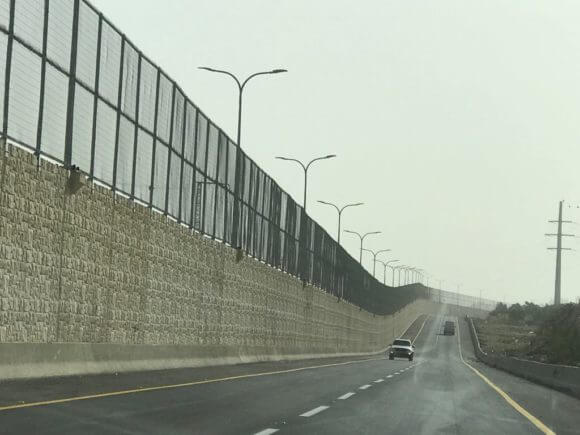It was only a matter of time, 66-year-old Mohammed Salameh said, before his hometown of Anata suffered another blow dealt by the Israeli occupation.
Located in the central occupied West Bank district of Jerusalem, less than 10 km north of Jerusalem City, the Palestinian town of Anata has seen it all: vast land confiscations, clusters of Israeli settlements built on its land, the Israeli separation wall, home demolitions, and residents killed and arrested by Israeli soldiers.
So when more of Anata’s lands were cut off last week when Israeli authorities opened Route 4370 highway, deemed by locals as the “Apartheid Road,” Salameh and his fellow community members were forced to continue on with their lives as usual.
“We were not surprised by the opening,” Salameh told Mondoweiss in the office of Anata’s municipality, where he works as the Coordinator of Land Protection in the town. “They have been working on this road for years, so we knew it would open eventually.”
When it was opened, stark images of the eight meter wall running through the middle of Route 4730 made international headlines.
The wall, made of concrete and topped with a fence, segregates the road into two separate two-way lanes: one side for Palestinians and one for Israelis.
“People around the world were shocked by this apartheid road,” Salameh said, “but in Anata, and all across the occupied lands of Palestine, we have already been living in a reality of apartheid for so long.”
“Despite what the Israelis say,” he continued, “things are going to get much, much worse for the people of Anata, and for all Palestinians in the West Bank.”
Demolition notices
As the international media buzzed about the new “Apartheid Road” near Anata, one reality of the highway’s inauguration was noticeably absent .
In the days leading up to the opening of the highway, Israeli authorities delivered over 20 demolition notices to homes in Anata located along the route.
“Twenty-one families brought the demolition orders to the municipality so we could file a complaint,” Salameh told Mondoweiss as he flipped through a binder full of demolition orders.

“But there are several more families who went to private lawyers, so the number is much higher than 21.”
According to Salameh, Israeli authorities delivered the notices to any homes within 300 meters of the highway under the pretext that the homes were built “illegally,” without Israeli-issued building permits.
“But most of Anata is built ‘illegally’ by Israeli standards, because they make it impossible to get building permits,” Salameh said.
After the Oslo Accords were signed in 1993, over 96% of Anata’s lands were designated as Area C, meaning that almost the entirety of the village was under full Israeli security and civilian control.
Palestinians living in Area C must apply for Israeli construction permits if they want to build on their land. But nearly all Palestinian applications for building permits are denied by the Israeli authorities, forcing communities like Anata to build illegally.
“There have been many demolition orders issued in Anata over the years, especially when the wall was built in the early 2000’s,” Salameh said, pointing out that Israel’s separation wall extends 20km over Anata’s lands and isolated nearly 50% of the town’s total area on the other side of the wall.
“But while many people are focusing on this Apartheid road, rightfully so, they are ignoring the fact that this road is having even more devastating effects on the people of Anata,” Salameh said.
In addition to the home demolition orders, any families from Anata who own land within 300 meters of either side of the road are now be unable to cultivate or work on their lands, as per Israeli orders.
“I own more than 30 dunums in this area,” Salameh said. Not only is it now more difficult to access because of the barriers on the side of the road, but if I do go and work on my land, I could be attacked by Israeli soldiers for ‘illegal activity’.”
“It is plain and simple, they are using this road as a means of further land confiscation in Anata,” he said. “Just as they have done in our town for decades.”

‘Things will only get worse’
When Route 4730 was opened, Israeli authorities hailed the new highway as a “gift” to Palestinians in the occupied West Bank.
Israel Afrayat, transportation coordinator for Israel’s Civil Administration, appeared in a promotional video explaining the purpose of the new road, which he said is meant to “serve all people.”
“Our goal is safety first – to protect your children,” Afrayat said in the video, published on COGAT’s Arabic-language Facebook page.
Israel’s Public Security Minister Gilad Erdan called the road “an example of the ability to create a shared life between Israelis and Palestinians, while dealing with the existing security challenges.”
“This is just a lie,” Salameh told Mondoweiss.
“In what way would this benefit Palestinians at all?,” he asked, adding that Palestinians with West Bank IDs who carried permits to go to Jerusalem could not use the road to get to the city.
“I, like thousands of people in Anata and the surrounding areas, have a permit to go to Jerusalem,” he said. More than 20% of Anata’s residents work in Israel.
“But instead of using the Israeli road to go straight to Jerusalem, I have to go through the crowded Shufat checkpoint, or sometimes if that is closed, all the way to the Qalandiya checkpoint.”
Salameh told Mondoweiss that when he is forced to travel through the Qalandiya checkpoint between Ramallah and Jerusalem, it can take him up to 3 hours to get from Anata to Jerusalem.
“If I were able to use this road to Jerusalem, it would take me less than 10 minutes from Anata,” he said. “So it’s just not true that this road is benefiting Palestinians.
While the highway’s Israeli side takes Israeli settlers, as well as Palestinians with Jerusalem IDs and Israeli citizenship, straight through to Jerusalem’s French Hill neighborhood, the Palestinian side of the road — for those with West Bank IDs — diverges into three pathways: one to Jericho, one to the town of Eizariya that leads to Bethlehem, and one leading north to Ramallah.
“The Israelis claim that the road is significantly faster for Palestinians, but we have calculated the time difference and it is only faster by a few minutes,” Salameh said.
“What they have not said is how the tens of thousands of Palestinians living in neighboring towns will now be traveling through Anata to reach the road, significantly increasing the traffic congestion in our town.”
Anata, like many other majority-Area C Palestinian towns in the West Bank, is plagued with crumbling infrastructures and the inability to fix roads due to Israeli restrictions.
“There is one main road that runs through Anata,” Salameh said, as he pointed down to the narrow two-way road from the roof of the municipality building.
“Due to the overcrowding in Anata and inability to fix the roads in most of the town, we already suffer from lots of traffic congestion,” he said.
Salameh pointed to the Shufat refugee camp on a congested hilltop north of Anata.
“There is one checkpoint for more than 20,000 people in Shufat to enter in and out of Jerusalem,” he said. “If the Israelis decided to close that one checkpoint, all of that traffic would suddenly be pushed through Anata.”
“If people start to come through here from Shufat and the surrounding areas, no one will even be able to reach this new highway, let alone use it for faster travel.”
Salameh continued, saying he hoped Palestinians would boycott the road as a sign of their refusal to accept Israeli policies on occupied land.
“If we use this road, we are just playing into their hands and helping them with their bigger plans for this area.”

Israel’s end game
The “bigger plans” Salameh was referring to, are Israel’s ‘Greater Jerusalem’ or ‘E1’ plan.
The road, which has been years in the making, is a key infrastructural part of implementing the plan, which seeks the de facto annexation of the three settlement blocs adjacent to Jerusalem city.
If implemented, the southern West Bank would be completely cut off from the north, making a future contiguous Palestinian state nearly impossible.

According to Israeli NGO Ir Amim, the ‘Apartheid Road’ was designed to “solve the dilemma of E-1 splitting the West Bank into northern and southern enclaves by using road infrastructure to preserve a semblance of contiguity between Ramallah and Bethlehem.”
By allowing Palestinians to still navigate between Ramallah and Bethlehem — in a very indirect manner — while diverting them from both the E-1 area and Jerusalem, the road eliminates a significant Palestinian presence.
“While legislative initiatives like the Greater Jerusalem Bill and other plans designed to redraw the boundaries of the city may be stalled, infrastructure projects have already proven an effective tool for increasing connectivity between the blocs and the city, not only by solidifying physical linkages but also by eroding the boundaries of the city in the Israeli public consciousness,” the group said.
“The Israelis are trying to market this road as something good and efficient for Palestinians,” Salameh said, “they want us to believe they are doing something good for us. But in the end they are just going to steal more of our land, as they do.”



Wonder how much that road and wall with fence atop cost us US taxpayers? All money gifted to Israel is fungible in Israel
The Apartheid Highway is just plain ugly, both in sheer physical appearance and in ethical/moral meaning.
Yet, what could be a more fitting symbol for Israel and its future than this bizarre road?
You know, there really are only a few possible ultimate outcomes for the social/political/humanitarian horror Israel has itself created.
One, a single state.
Two, two states.
Three, all of the Palestinians are somehow made to go away.
Four, apartheid.
Israel has itself ruled out the first two of these.
The third is not realistically possible. The world has accepted a great deal of lawlessness from Israel, but ethnic cleansing on the scale of millions just will not be tolerated.
Anyway, there is no place for millions to go. No state or states would accept such an immense burden.
Which leaves the fourth, apartheid, and it is what Israel is vigorously working towards, without ever announcing the fact or using the word.